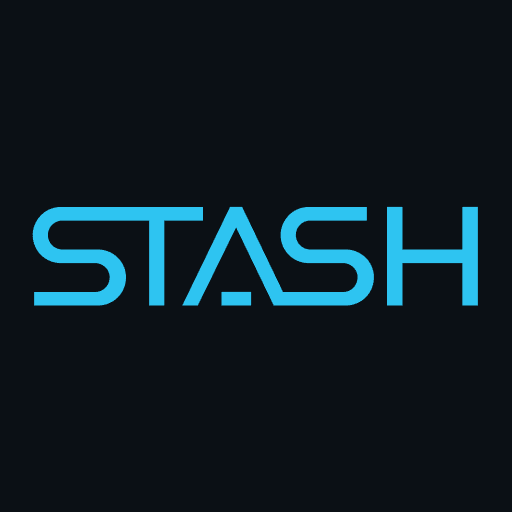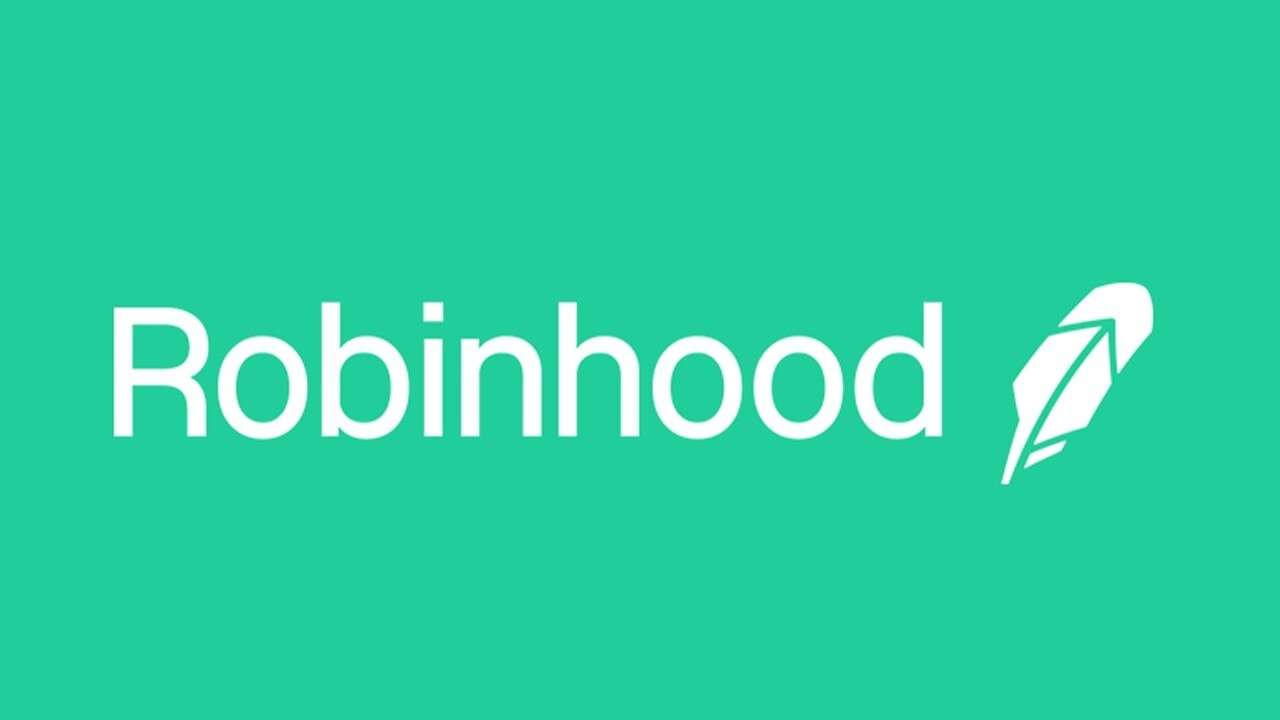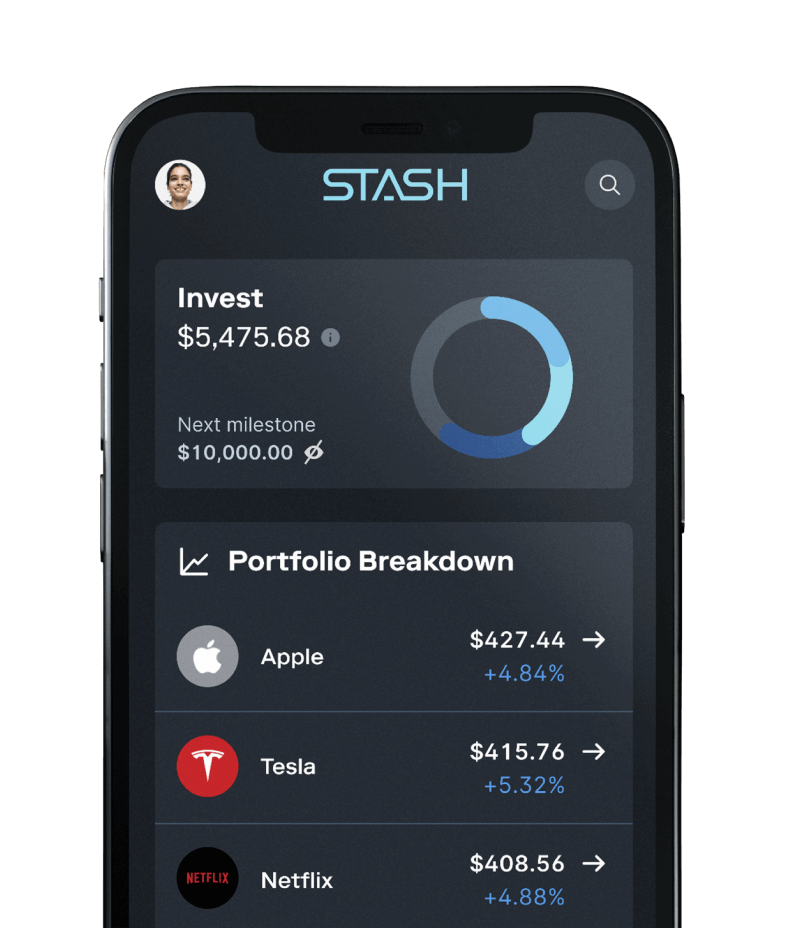
Quick Comparison
| Feature |  |  |
|---|---|---|
| Overview | Investing, budgeting, and banking app that aims to simplify personal finance. | No commission trading platform for equities, options, and crypo. |
| Trading Commissions | $0 | $0 |
| Type of Investment Accounts | Taxable Brokerage, IRA, UGMA/UTMA | Taxable Brokerage |
| Fractional Share Trading | No | Yes |
| Cryptocurrencies | No | Yes |
| Options Trading? | No | Yes |
| Mobile App | Yes | Yes |
| Auto-investing? | Yes | Yes |
| Margin Trading | No | Yes, $5 per month |
| Reoccurring Fees | $3, or $9 (unavoidable) | No |
What is Stash?
Stash is an investing and personal finance app aiming to simplify banking, investing, and advice within a single app. Their mission is to help Americans reach their financial goals with a low monthly fee.
For a small monthly fee of $3, Stash users can budget, build a portfolio, and save for retirement, all within one app.
Stash was founded in 2015 and has over 6 million users on its platform.
The company is headquartered in New York City.
What is Robinhood?
Robinhood is a mobile-first investing app that focuses on active investors who trade frequently. The company became one of the first brokerages to offer commission-free stock and options trading with a minimum investment of just $1.
Robinhood is publicly-traded on the NASDAQ and has 31 million users.
How Does Stash Work?
Stash aims to create long-term wealth.
When you open an account with Stash, they will ask you basic financial questions like your financial goals and plans. Your answers are used to provide specific advice for investing and budgeting.
After that, you choose your subscription plan, starting at just $3/month, giving access to a brokerage account, retirement account, and Smart Portfolio.
You also will receive the Stock-back card, which allows you to earn stock when spending. Depending on your plan, you get access to additional features like budgeting & saving tools, education, and much more.
How Does Robinhood Work?
Robinhood caters to active traders and only offers taxable brokerage accounts. Through Robinhood, investors can trade stocks, options, ETFs, and cryptocurrencies on a whole or fractional share basis.
Robinhood offers two tiers of investment accounts. A free, their most popular version, and a premium version (Robinhood Gold) for $5 a month offers access to market research, real-time data, and a lower margin rate.
Head-to-Head Comparison
Account Types
Winner: Robinhood
Both Stash and Robinhood offer taxable brokerage accounts. However, Stash also offers retirement accounts such as Traditional and Roth IRA accounts plus custodial investment accounts for children when you opt-in for its Stash+ account.
Robinhood does not provide other investment accounts outside of a taxable brokerage, such as retirement accounts.
Investment Options
Winner: Robinhood
Both Stash and Robinhood offer fractional share trading, stock, and ETF trading. With Robinhood, you can buy and sell as long as the market is open. Meanwhile, Stash only has 4 trading windows.
Robinhood also offers options trading for US equities, crypto investing in bitcoin and six other cryptocurrencies, and margin investing.
A unique feature Robinhood offers that is not available on Stash is IPO Investing. Robinhood offers individual investors public access to upcoming IPOs.
This means everyday investors like you and me can purchase securities at the IPO price. IPO access was once only available to the ultra-wealthy and institutional investors.
Robinhood allows trading in the following asset classes:
- U.S. Exchange-Listed Stocks and Exchange Traded Funds (ETFs).
- Options Contracts for U.S. Exchange-Listed Stocks and ETFs
- ADRs for over 650 Globally-Listed Companies
- Crypto such as bitcoin and six other cryptocurrencies
- Fractional shares
Robinhood does not allow trading in the following asset classes:
- Mutual Funds
- Bonds
- Closed-end funds
- Foreign-domiciled stock
On the other hand, Stash offers more limited investment options:
- Fractional shares
Fees
Winner: Tie
Robinhood nor Stash charges any transaction fees. However, both platforms may charge a reoccurring monthly fee depending on your account tier. Robinhood Gold is $5 a month, while Stash Growth is $3/month and Stash + is $9/month.
There is no free version with Stash because their objective is to make your investing and banking experience more specialized. Meanwhile, Robinhood’s Instant Account offers no frills, with little to no personalization.
Stash Account Tiers & Fees
$3 per month for Growth accounts. You get a taxable brokerage account, a stock back card, a Roth or Traditional IRA, and $1,000 of life insurance with a growth account.
$9 for Stash+. With a Stash+ account, you get a traditional brokerage, a Roth or Traditional IRA, an investment account for children, monthly market insights, and $10,000 of life insurance.
Reading the fine print, Stash also notes, “You may incur ancillary fees charged by Stash and/or its custodian that are not included in the monthly Wrap-Fee.”
Robinhood Account Tiers & Fees
Robinhood Instant. A Robinhood Instant account is Robinhood’s free account tier, there are no trading or reoccurring maintenance fees with its Robinhood Instant account.
Robinhood Gold. For $5 per month, the Gold Account provides users with all the features of an instant account, plus: a lower margin rate, more significant access to unsettled funds, third-party market research, and Level II market data from Nasdaq.
So if you are looking for a truly 0 cost option, Robinhood is your winner. It is not possible to open an account with Stash without paying a reoccurring monthly fee.
- Trading Fees: None
- Margin Trading: 9.75%, 5.75% with Robinhood Gold
- Inactivity Fees: None
- Miscellaneous Fees: ACATs (Outgoing): $75, Domestic overnight check delivery: $20, Paper Statements: $5, Paper Confirms: $2
Other Features
Outside of traditional investment options, fees, and types of accounts available, both Robinhood and Stash offer unique features that might tip you over the edge.
Noteworthy Stash Features
Stash Stock Back. When you use your Stash debit, you earn 0.125% on everyday purchases and up to 5% for specific merchants, with bonuses. In general, everyday purchases such as gas, groceries, travel, and dining—will earn you stock.
Plus, the Stash debit card does not have any hidden fees. So, no overdraft or maintenance fees, plus no minimum balances in addition to 19,000 fee-free ATMs.
Noteworthy Robinhood Features
Robinhood Cash Card. Like Stash, Robinhood offers a debit card that enables you to earn cash back that’s reinvested into stock and cryptocurrencies.
You can earn 10% – 100% bonuses on your weekly round-ups. Round-ups are capped at $100/week, and bonuses are $10/week.
Earn Income on Stocks You Already Own. Stock Lending gives you the opportunity to earn extra income through stocks you already own.
Once you turn on Stock Lending, Robinhood does the work to find borrowers. If there’s a match, the income earned is paid monthly. You will be able to sell your stocks at any time with the same gains or losses.
Income from Stock Lending will likely vary from month to month. You’re more likely to earn money when there’s high market demand and low market availability for the stocks you own.
Mobile Experience

Stash has 4.7 out of 5 stars in Apple Store and a 4.1 rating out of 5 in the Google Play Store.
Stash has a mobile app and a web-based user interface; however, it has been noted that the web-based services do not have the same services as the mobile app.
The Robinhood app is straightforward to use and user-friendly. The company was built with a mobile-first experience to make it extremely easy to use and an intuitive user interface.
The Robinhood app has a 4.1 out of 5-star rating in the Apple store and 3.8 out of 5 in the Google Play Store.
Pros & Cons
Stash
| PROS | CONS |
|---|---|
| Earn stock when you make purchases with your debit card | No crypto trading |
| Brokerage, IRA, and custodial accounts are available | No options trading |
| Earn stock when making purchases using your debit card | Limited ability to day trade |
Robinhood
| PROS | CONS |
|---|---|
| No commissions | Only taxable brokerage accounts are available |
| Access to margin trading | No access to in-depth market analysis |
| Access to funds before they settle | No direct access to fixed-income products |
Who Should Use Robinhood And Stash?
Robinhood is better for…
- DIY investors
- Active investors
- Taxable brokerages
- Margin trading
Stash is better for…
- Long-term, passive investing
- Retirement Investing
- Guided investment advice
Which Platform Is Better?
In reality, Stash and Robinhood target different audiences.
Stash is focused on individuals who want to build long-term wealth through investing and budgeting personalized to their unique circumstances.
Meanwhile, Robinhood focuses on investors who want to trade frequently and seamlessly, not those focused on long-term wealth-building.

